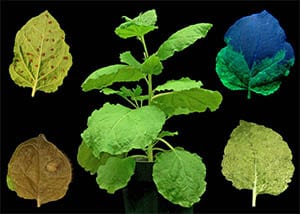News
A Wild Relative of Tobacco Offers Insight into Molecular Plant Biology at BTI
 The genome of an experimentally important relative of tobacco has been sequenced by US and Canadian researchers. Nicotiana benthamiana, which grows wild in Australia, is widely used for experiments to study the interactions between plants and pathogens and other areas of plant biology.
The genome of an experimentally important relative of tobacco has been sequenced by US and Canadian researchers. Nicotiana benthamiana, which grows wild in Australia, is widely used for experiments to study the interactions between plants and pathogens and other areas of plant biology.
Several scientists from the Boyce Thompson Institute for Plant Research (BTI), Ithaca, New York and the Université de Sherbrooke, Département de Biologie, Sherbrooke, Quebec, Canada have published a draft genome sequence of N. benthamiana on the Sol Genomics Network (solgenomics.net) and in the journal Molecular Plant Microbe Interactions on August 8, 2012. BTI scientists Greg Martin, Lukas Mueller, Aureliano Bombarely, Hernan Rosli, Julia Vrebalov and Sherbrooke scientist Peter Moffett worked together to generate the sequence, which contains information of more than 90% of the genes in this species.
Dr. Mueller and his team noted, “We are very excited about this publication, because it reports on one of the first allopolyploid species that have been sequenced and so it offers some insight into evolutionary biology, but more significantly the genome plays an important role as a model for plant-pathogen interactions, thereby laying some essential ground work for understanding plant biology.” The researchers are currently annotating the genome sequence to let researchers know specific details about its estimated 75,000 genes. All the data generated in this project are publicly available at: http://solgenomics.net/organism/Nicotiana_benthamiana/genome.
N. benthamiana is susceptible to attack by a large number of bacterial pathogens, for example the intensively-studied bacterial pathogen, Pseudomonas syringae, as well as viral and fungal pathogens and insects pests. This vulnerability gives scientists the opportunity to study how the plant reacts to each of these organisms and the availability of the host’s genome sequence allows for the study of the particular genes involved within the plant’s defense system. With this knowledge, scientists can better understand how plants defend themselves from attack and can use this information to breed pest resistant plants.
As Dr. Martin stated, “N. benthamiana is widely used for research on plant diseases and the genome sequence will enhance the ability to discover new genes that play a role in the plant immune system.”
The plant’s popularity derives from how the plant reacts to diverse pathogens and its amenability to virus-induced gene silencing (VIGS). VIGS is a widely used method to knock down gene expression in N. benthamiana because it is simple to implement, effective, and fairly quick–with the process only taking about month. The process helps identify genes associated with immunity and facilitates a deeper investigation of the specific genes that are important in plant-microbe interactions, as well as many different aspects of plant biology.
Being part of the Solanaceae family, N. benthamiana provides a great resource to compare it to its relatives, the tomato and potato. With the availability of genome sequences from all three of these species, more detailed and exact understanding of how the different genes work can be analyzed, possibly leading to the development of more hardy, disease resistant crops.
The scientific journal article can be found here:
http://apsjournals.apsnet.org/doi/abs/10.1094/MPMI-06-12-0148-TA?url_ver=Z39.88-2003

